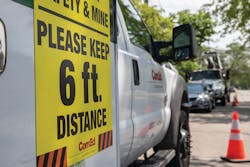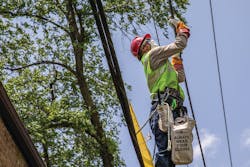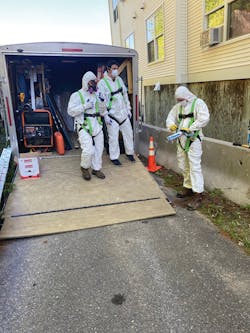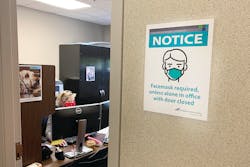Utilities See Logistical Nightmares, Emotional Anguish as Pandemic Continues
Utilities are settling in for a longer fight than perhaps they first expected earlier this year when authorities first recommended people isolate themselves to stop the spread of COVID-19. Sources now are saying the pandemic will affect us — in some way — for years to come. Those responsible for keeping the lights on express great pride in the necessity and importance of their work as well as in the toughness of those doing the work, especially during these uncertain times.
Dwayne Cartwright, president and CEO of Berkeley Electric Cooperative in Moncks Corner, South Carolina, U.S., said dealing with the virus on top of everything else his utility crews must contend with puts workers through physical as well as emotional hardship.
“I want to talk a bit about the mental anguish that this is causing. If you go through a hurricane, you can see the light at the end of the tunnel. It gives you a certain amount of confidence you can get it done. But I think t his virus is just starting to wear on my folks. It’s a lot to ask of them, having to work safe and still having to do the job. It feels as though this will never end,” Cartwright said. “I want to make certain that they can work safe, but the mental side of it does affect us all.”
Furthermore, like many other workers across the U.S. and around the world, utility workers with children are wondering what the next few months will be like, Cartwright added.
“On top of that you have the uncertainty of whether school will open this fall and where their children might be. Whether they might have to find someone to take care of them. It’s giving them so much to think about. It’s important for me to consider everything that my guys are going through,” Cartwright observed.
Pandemic Strategies
One thing that has not changed is utilities supporting one another through skill sharing and hard work. Aleksi Paaso, director, distribution planning, smart grid and innovation at Commonwealth Edison Co. (ComEd) in Chicago, Illinois, U.S., believes knowledge sharing has been key for utilities throughout the pandemic response.
“This pandemic is not a local event. All of us are affected by it, but we are responding in the same way we would to any other disaster: We are supporting each other through knowledge sharing,” Paaso said.
Paaso is one of the lead authors of a paper for IEEE’s Power & Energy Society on the energy industry’s response to COVID-19, which found, among other things, utilities continually are improving their pandemic strategies.
“Many utilities, including ComEd, had pandemic plans prior to the COVID-19 pandemic. We were fortunate that one of the previous epidemic scares that never materialized here in North America was SARS in 2003, which is caused by another coronavirus and transmitted in a similar manner to COVID-19,” Paaso recalled. “We were informed by these past experiences when we developed our plans for this pandemic, and we’re constantly refining them.”
The industry, Paaso said, spends a lot of time planning for both natural and man-made disasters that could potentially interrupt the power supply, and one of the most basic response strategies is mutual assistance. This entails utility crews from other regions traveling to the site of a major disaster to help local crews respond.
Cartwright is not sure whether Berkeley Electric will be able to take advantage of mutual assistance networks the way they usually do, because of COVID-19.
“We rely a great deal on mutual aid from Texas, Florida, Georgia. These are states we usually get workers responding from and, honestly, they may not be coming this year,” Cartwright noted.
His co-op, whose service territory is near South Carolina’s coast and includes the outskirts of Charleston, already has had to contend with tornado-producing thunderstorms that caused outages in April 2020, which provided perhaps a preview of sorts for the coming hurricane season.
“Hurricane season is warming up, and we are going to have to respond to that,” Cartwright said, adding that staging crews safely during a pandemic may require rethinking the usual methods.
In the past, for example, crews would all be put up in a large hotel. Would that still work during a pandemic?
During the April thunderstorms, Cartwright said crews came in from each of his utility’s four districts and were fed and housed in the field without going home. They had access to the proper equipment, protective gear and testing supplies.
“That tornado was a pretty good test of the new way of doing things,” Cartwright said, but he added that a hurricane would fall across a much larger area.
He said storm outages may last longer if utilities cannot safely field the same number of workers as before the pandemic. Normally, there is a mandatory lockdown period when a storm is a few days out and workers are required to come in and not move prior to the event.
“We have limited the number of folks who will be coming in. We are working with state authorities, and it kind of depends on how the hurricane approaches. The state is trying to limit drive times within an area. When we look at bunking these folks, we are evaluating whether we need to minimize outside crews and also how we can sanitize the rooms properly. It could be a logistical nightmare that we have to deal with,” Cartwright explained.
Berkeley Electric has limited crews to two people per service vehicle as a health precaution.
“We want the same crew to work in the same truck every day, so if there is an exposure, we lose two workers instead of a whole team,” Cartwright said. “The issue we are having right now is it’s very hot and it’s tough on our work crews, in their gloves, helmets, [personal protective equipment] and now masks.”
The Move to More Virtual
Brad Williams, vice president of industry strategy at Oracle Utilities, said customers and utility workers alike are having to rethink the way things normally are done.
“For example, one utility arranged to have control room support staff monitor the grid from home,” Williams shared.
However, for many of the essential services they provide, utilities are finding they must leverage available space such as emergency operations centers and training rooms to spread out control room operators and on-floor supervision and support to maintain social distancing guidelines, Williams said.
Field crews are getting special training on using extra personal protective equipment to support COVID-19 best practices, but technology companies like Oracle also are looking at solutions that limit human exposure or remove it altogether.
“On the construction side, in particular, Oracle has been working with several partners to incorporate new technologies into the mix to help support safety measures. These range from robots that scan the work site, [radio-frequency identification] tagging for material tracking, imaging technology and special lanyards that identify when people are getting to close together and more,” Williams said.
Jobs formerly considered in person only have adopted a virtual model in the age of COVID-19, Williams noted, such as home energy audits. For example, one Midwest utility offers its assessment program online, which means customers complete their home energy assessments online. No one from the utility ever needs to enter a customer’s home.
Eversource Energy’s Vice President of Energy Efficiency Tilak Subrahmanian said his utility temporarily had discontinued such energy audits early in the pandemic but were able to resume them as the situation improved in New England.
“When social distancing and isolation first began, we started suspending anything that required us to go into customer homes,” Subrahmanian recalled. “As you could imagine, that was a lengthy list. We rolled out a lot of online virtual training for a whole host of things.”
The Northeast U.S. went through a rough patch with COVID-19, but Subrahmanian said infection rates slowed enough for Eversource to resume its home energy assessment program.
“We have done about 3000 to 4000 of them now. At first it was a little clunky as you might imagine, but the process has become more smooth,” he said, adding that health precautions are a primary consideration of the program, with the secondary concern being to help small businesses get back to work.
Eversource offers safety training and equipment to contractors doing the energy audit work, and Subrahmanian said this program has been well-received by the utility’s contractors.
Higher Energy Bills
Williams agreed with Subrahmanian on the need to put people back to work.
“Right now, there is a perfect storm of high unemployment and furloughed workers who are being required to spend more time at home due to COVID-19. This is resulting in a larger number of high bills,” Williams explained.
In March 2020 alone, Oracle Utilities’ Opower alerted 400% more people of high forecasted bills in 2020 compared to March 2019. In one western state, half of customers saw higher utility bills. In response, utilities have continued their moratoriums on shutoffs and are offering new kinds of payment plans, Williams said.
Opower also has used layered data sets to more accurately identify households that might be struggling financially.
“We have found that the demographic data sets often used to identify limited-income households can have blind spots that bias against effectively identifying limited-income households. By layering in other data sets, both public and proprietary, we helped one utility find that more than 410,000 of their customers were energy burdened, [a 78% increase over what they previously thought],” Williams noted.
Rising to the Occasion
Williams said utilities are built to operate through emergencies, and COVID-19 is no exception. He is confident of the industry’s ability to weather this storm.
“While some investments may be delayed due to the need to halt rate increases this year, utilities are still concerned and focused on the things they were prior to the health crisis,” he noted.
Paaso said for the continental U.S., IEEE observed load shapes gradually change as stay-at-home orders initially were implemented across the country throughout March and April 2020. Some changes were driven by weather patterns and the overall customer mix, but other changes were more directly attributable to COVID-19.
“People are adjusting to a different lifestyle, and they are trying new things that affect their consumption patterns. Some of these changes may become the norm, others will subside as we go back to higher levels of activity outside of the home,” Paaso said.
The industry must plan carefully for uncertainty in demand and work to make sure it can meet the demand, whatever it is.
“One way we do this is by adjusting our forecasts,” Paaso noted. “For example, some utilities adjusted weekday forecasts to match weekend forecasts or holiday forecasts.”
To ensure they could meet demand, some utilities re-forecast feeders that were previously above a specified threshold level to determine if the new load patterns presented a risk of overloading. They then took appropriate action based on the results.
IEEE’s white paper also found people are using more electricity at home even outside of work hours, as usage goes up in the evening. Why are people are using more electricity after work?
“We don’t really know yet, except to say that...people are adjusting to a different lifestyle, and they are trying new things that affect their consumption patterns. Some of these changes may become the norm, others will subside as we go back to higher levels of activity outside of the home,” Paaso said.
Paaso said his time spent looking into how utilities are coping with COVID-19 only has raised his opinion of the industry.
“This effort made me realize how proud I am to be working in an industry that is in this together to the degree that we are. We have all been so incredibly busy responding to this situation and ensuring that our core responsibilities — providing safe, reliable power to our customers and a safe working environment for our workforce — are met, but everyone has made the effort necessary to respond as needed,” Paaso observed.
“It’s a trying time, but we are able to keep things going,” Cartright added. “The linemen will push through it. They will rise to the occasion.”
COVID-19 Timeline
April 3: The U.S. Centers for Disease Control and Prevention starts testing the antibodies of asymptomatic carriers.
April 12: The IRS sends the first COVID-19 stimulus checks to Americans.
April 17: Several protests of state lockdown orders are reported in the U.S.
April 29: The National Institutes of Health says Remdesivir is better than a placebo for treating COVID-19.
April 30: Approximately 26.5 million Americans have filed for unemployment since social isolation began.
May 1: Distancing orders slacken in certain states, including Texas, Georgia and Ohio.
May 8: U.S. unemployment now is worse than during the 2008 Great Recession (14.7%).
May 9: At-home COVID-19 tests become available.
May 17: Japan and Germany slide into recession.
May 21: U.S. reaches a deal with AstraZeneca to develop the AZD1222 vaccine. Phase 3 clinical studies proceed through the summer.
May 28: U.S. passes 100,000 deaths from COVID-19.
May 31: Mass protests over police brutality against Black Americans sweeps 75 U.S. cities. Despite concerns of infections, protests did not lead to a surge in cases.
June 10: U.S. passes 2 million documented cases as infection rates spike from a lowering of social distancing in some states.
June 16: Airlines reportedly ban passengers who do not wear face masks.
June 17: COVID-19 outbreaks seen in Africa, Latin America, South Asia and the U.S.
June 18: The World Health Organization ends its testing of hydroxychloroquine as a COVID-19 treatment.
June 22: Restaurants and retail begin to reopen in New York City. Saudi Arabia announces Hajj travel restrictions.
June 24: Washington State issues a mask requirement in response to a spike in cases.
June 25: Health authorities estimate the number of infected in the U.S. could be up to 20 million, despite only 2.3 million cases documented.
July 6: Restaurants are closed in Florida in response to a spike in cases.
July 7: Brazil President Jair Bolsonaro tests positive for COVID-19. Also, Director of the National Institute of Allergy and Infectious Diseases Anthony Fauci recommends wearing masks in public.
July 11: Walt Disney World reopens to the public, with certain health measures in place.
July 10: Hong Kong is hit with a third wave of COVID-19 and shuts down schools.
July 13: California shuts down many businesses because of a spike in cases.
July 15: Walmart requires masks for all customers and staff.
July 17: India reaches 1 million cases and tightens lockdown restrictions.
July 22: President Donald Trump urges Americans to wear face masks.
July 26: U.S. government hands an additional $470 million to pharma company Moderna for its COVID-19 vaccine, currently in its third stage of trials.
About the Author
Jeff Postelwait
Managing Editor
Jeff Postelwait is a writer and editor with a background in newspapers and online editing who has been writing about the electric utility industry since 2008. Jeff is senior editor for T&D World magazine and sits on the advisory board of the T&D World Conference and Exhibition. Utility Products, Power Engineering, Powergrid International and Electric Light & Power are some of the other publications in which Jeff's work has been featured. Jeff received his degree in journalism news editing from Oklahoma State University and currently operates out of Oregon.




